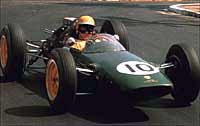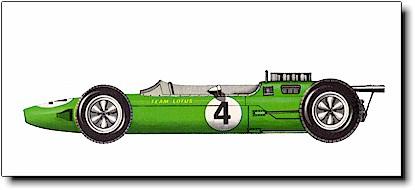Lotus 25 Coventry Climax

Active: 1962 - 1967
Team: Team Lotus
Designer: Colin Chapman
While the Formula One grid at the time was filled with tubular steel frame chassis, Lotus designer Colin Chapman thought out an idea to replace the frame with a new type of structure. Out of an idea sketched on a restaurant napkin an aluminium space frame was developed which was structurally stronger and lighter thanks to L72 aluminium alloy used in the frame. The main benefits of this design were increased torsional rigidity for lees weight and with a smaller frontal area. The resulting stiffness allowed Lotus to use more supple suspension which offered great advantages in slower, tighter turns.
 The car's main structure was made out of box sections built around the drivers seat. In both the left and right boxes fuel is carried in rubber tanks to use the internal space in the frame.
The car's main structure was made out of box sections built around the drivers seat. In both the left and right boxes fuel is carried in rubber tanks to use the internal space in the frame.
Because of the solid structure moulded as one part, this car is known as being the first monocoque ever in F1. At the time though, Lotus was also developing the Lotus 24 which was built like a traditional spaceframe: "I'd never seen one before and we didn't know if it would work. We sold the spaceframe to our customers. We could not sell them a revolutionary car which might not work at all and might need a long and expensive development programme. At that time it was really an unknown animal". The Lotus 25 was a risk, but just like many other novelties introduced in F1 by Chapman, it proved to be a very good one.
The new structure could be made so compact that drivers in the Lotus 25 seemed like lying down instead of sitting in the car. The car was therefore also known at "the bathtub". In fact when the first prototype was being built Chapman took the opportunity of sitting in the car. To his surprise he found that he could fit quite comfortably and announced forthright that: "This cockpit's too wide ... take another inch and a half out out of it!" Dick Scammell, one of the mechanics that built the first car would later remark that: "None of us really knew what we were doing, but it all took shape very nicely and it certainly looked right."
 The difficulty building the monocoque was not to make the pontoons stiff, but to join them in such a way they are held rigidly parallel to each other, no easy matter. The methods conceived for the car were virtually those of everyone since. Two vital bulkheads, one behind the driver and one beyond his feet, link the two tubes, together with a marginally less rigid one at instrument panel level. Our two side tubes have become flattened into D sections, to permit economic insertion of the driver between them while keeping everything as narrow as possible. The engine was then bolted in behind the driver, making it one solid car. At the front an extra small frame was built to contain steering and suspension parts.
The difficulty building the monocoque was not to make the pontoons stiff, but to join them in such a way they are held rigidly parallel to each other, no easy matter. The methods conceived for the car were virtually those of everyone since. Two vital bulkheads, one behind the driver and one beyond his feet, link the two tubes, together with a marginally less rigid one at instrument panel level. Our two side tubes have become flattened into D sections, to permit economic insertion of the driver between them while keeping everything as narrow as possible. The engine was then bolted in behind the driver, making it one solid car. At the front an extra small frame was built to contain steering and suspension parts.
The car proved to be fast right at its launch. With Jim Clark at the wheel, the car was faster than the competition and Jim only narrowly missed out on that years World Championship after a bolt came loose in the last race of the season, causing him to lose all engine oil and forcing him to retire. In 1963, Engineer Len Terry returned to Lotus and worked to improve the cars reliability. His work bore fruit the next year, 1963 when Jimmy Clark won a then record seven races and the World Championship.
Specifications
Engine: 90 degrees V8 Coventry Climax
Bore X Stroke: 63 x 60 mm
Capacity: 1,498 cc
Power: 195 Bhp at 8.200 rpm

